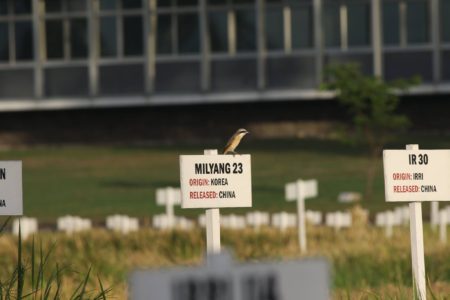Did I mention I also have a work blog, focusing on genebanky stuff? The latest post is about Pokémon Go. Yeah, I know, but trust me, it makes sense. Hopefully.
Brainfood: China cereal yield, US soybean breeding, Breadfruit genomics, Field app, Urban ag, Rose breeding, Strawberry cryo, Global biodiversity loss, Oceania bananas, Vegetable breeding, Badass Chinese sheep
- Patterns of Cereal Yield Growth across China from 1980 to 2010 and Their Implications for Food Production and Food Security. There has been yield stagnation over about 50% of total area of rice and maize, 15% of wheat.
- Genomic signatures of North American soybean improvement inform diversity enrichment strategies and clarify the impact of hybridization. 579 soybean varieties released 1940-2009 fall into 3 maturity groups, the overall diversity of which is not too different from the diversity of the ancestor landraces.
- Low-Coverage, Whole-Genome Sequencing of Artocarpus camansi (Moraceae) for Phylogenetic Marker Development and Gene Discovery. There’s been a whole genome duplication in Artocarpus.
- ColectoR, a Digital Field Notebook for Voucher Specimen Collection for Smartphones. So many of these things around.
- Potential ecosystem services of urban agriculture: a review. Important at local scale, not so much at global scale.
- Nineteenth century French rose (Rosa sp.) germplasm shows a shift over time from a European to an Asian genetic background. Ah, the lure of the exotic; 19 genetic groups, not corresponding to horticultural groups.
- Cryopreservation of in vitro shoot tips of strawberry by the vitrification method — establishment of a duplicate collection of Fragaria germplasm. The German national collection, including wild relatives, is a bit safer.
- Has land use pushed terrestrial biodiversity beyond the planetary boundary? A global assessment. Looks like it. Cross-reference with crop wild relatives?
- Traditional Banana Diversity in Oceania: An Endangered Heritage. Out of New Guinea…
- The contribution of international vegetable breeding to private seed companies in India. Vegetable breeding by AVRDC still has a role as R&D shifts to the private sector, but it’s different to what it was.
- Whole-genome sequencing of native sheep provides insights into rapid adaptations to extreme environments. Genomes of 77 Chinese breeds from extreme environments reveal genes likely to be useful in extreme environments.
Ancient agricultural DNA everywhere
Heady days for ancient DNA researchers. There have been two major papers in the past month looking at the DNA of Neolithic farmers. Back in June, a huge research consortium published “The genetic structure of the world’s first farmers” as a preprint in bioRxiv, with subsequent write-up in Nature. And now a different huge consortium comes out with “Early Neolithic genomes from the eastern Fertile Crescent,” in Science. That also got widely picked up.
Don’t ask me why two separate research groups need to be working on basically the same problem, in basically the same way. I suppose they’re using somewhat different methods on different material. I really couldn’t tell you whether it would have been better to pool the material, or standardize the methods, or indeed both. Maybe someone out there will tell us. In any case, it’s reassuring, I suppose, that the two studies came to broadly similar conclusions, namely that there were genetic differences among early farmers, and that genetically distinct people from different parts of the Fertile Crescent migrated north into Europe and eastwards further into Asia. Which in turn suggests to some that the origins of agriculture may be described as “federal”:
Different and genetically distinct populations were all engaged in this same general project, albeit exchanging ideas with each or other or sometimes coming up with the same idea independently.
Meanwhile, sequencing of DNA from a 6000-year-old barley from the Dead Sea shows close similarity with varieties still grown in the southern Levant and Egypt. Intriguing to speculate whether a similar study of material from the Zagros Mountains would show a parallel pattern to the human DNA. But will it need a different group of researchers to do it.
Brainfood: Ghana cassava, Paspalum hybrids, Wild safflower, Genotyping for phenotyping
- Tracking crop varieties using genotyping-by-sequencing markers: a case study using cassava (Manihot esculenta Crantz). A third of cassavas found on Ghanaian farms are released varieties, though you’d never know it from just looking at the names.
- Interspecific hybrids between Paspalum plicatulum and P. oteroi: a key tool for forage breeding. P. oteroi is promising, but asexual. But there’s a way around that…
- Phylogenetic position of two endemic Carthamus species in Algeria and their potential as sources of genes for water use efficiency improvement of safflower. They’re actually in a different genus, but could still be useful.
- Genomic Prediction of Gene Bank Wheat Landraces. “…for the two populations of landraces included in this study [Mexican & Iranian], genomic predictions were generally of a magnitude that could be very useful for predicting the value of other accessions in the gene bank and that could be useful in breeding.”
One for the birds
There’s a great set of photographs on the Facebook page of Leo Sebastian, Regional Program Leader, Southeast Asia at CGIAR Research Program on Climate Change, Agriculture and Food Security, based in Los Baños, Philippines. It’s entitled Birds in Rice Selection, and the idea behind it is pretty simple:
How about using birds to select for new rice varieties? Observing the birds in the field, they prefer certain varieties to feed on. Such observation can give us a clue of certain grain quality characteristics.
Here’s an example.

Milyang 23 is apparently a popular Korean rice variety. I wonder how they record the results in the database.